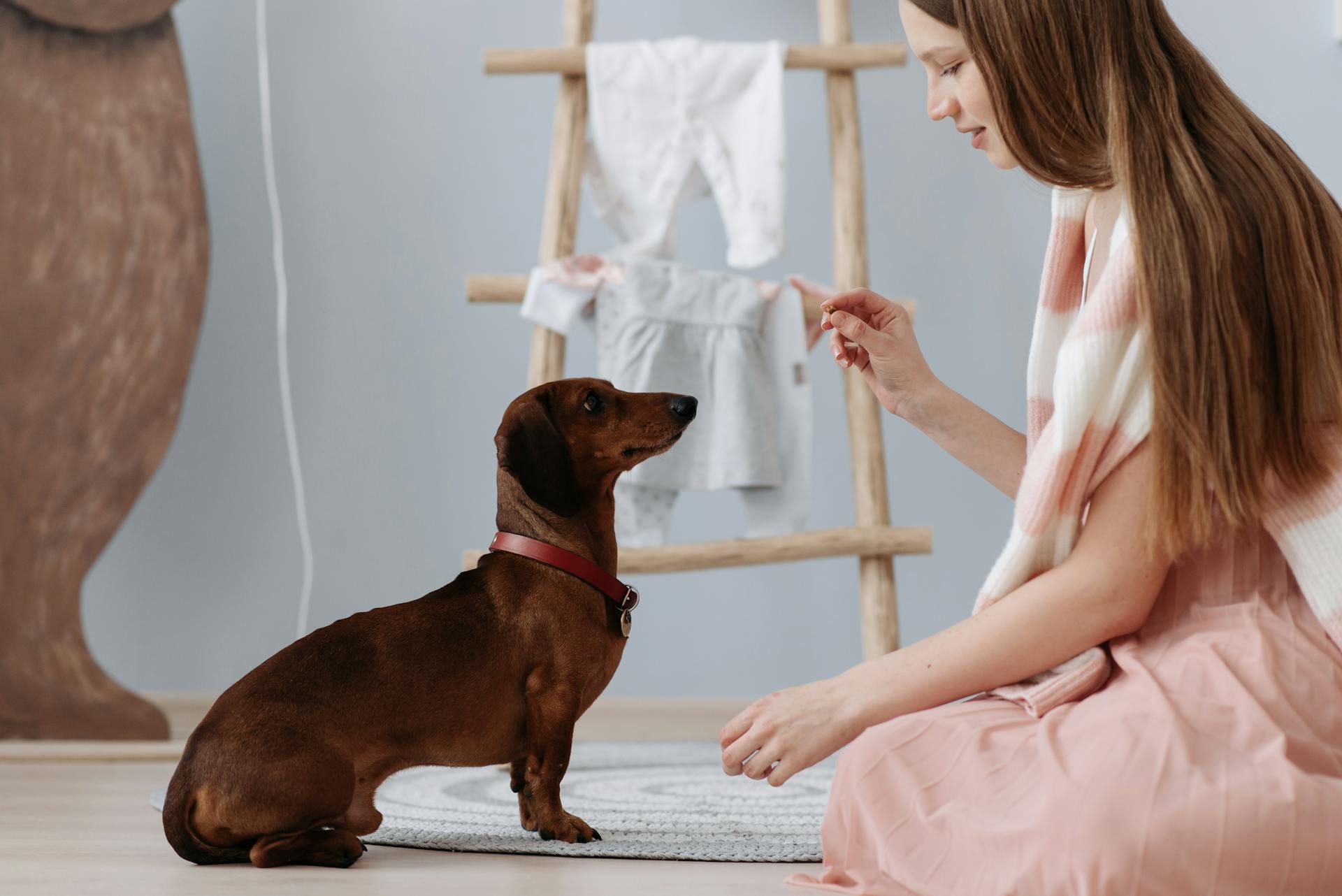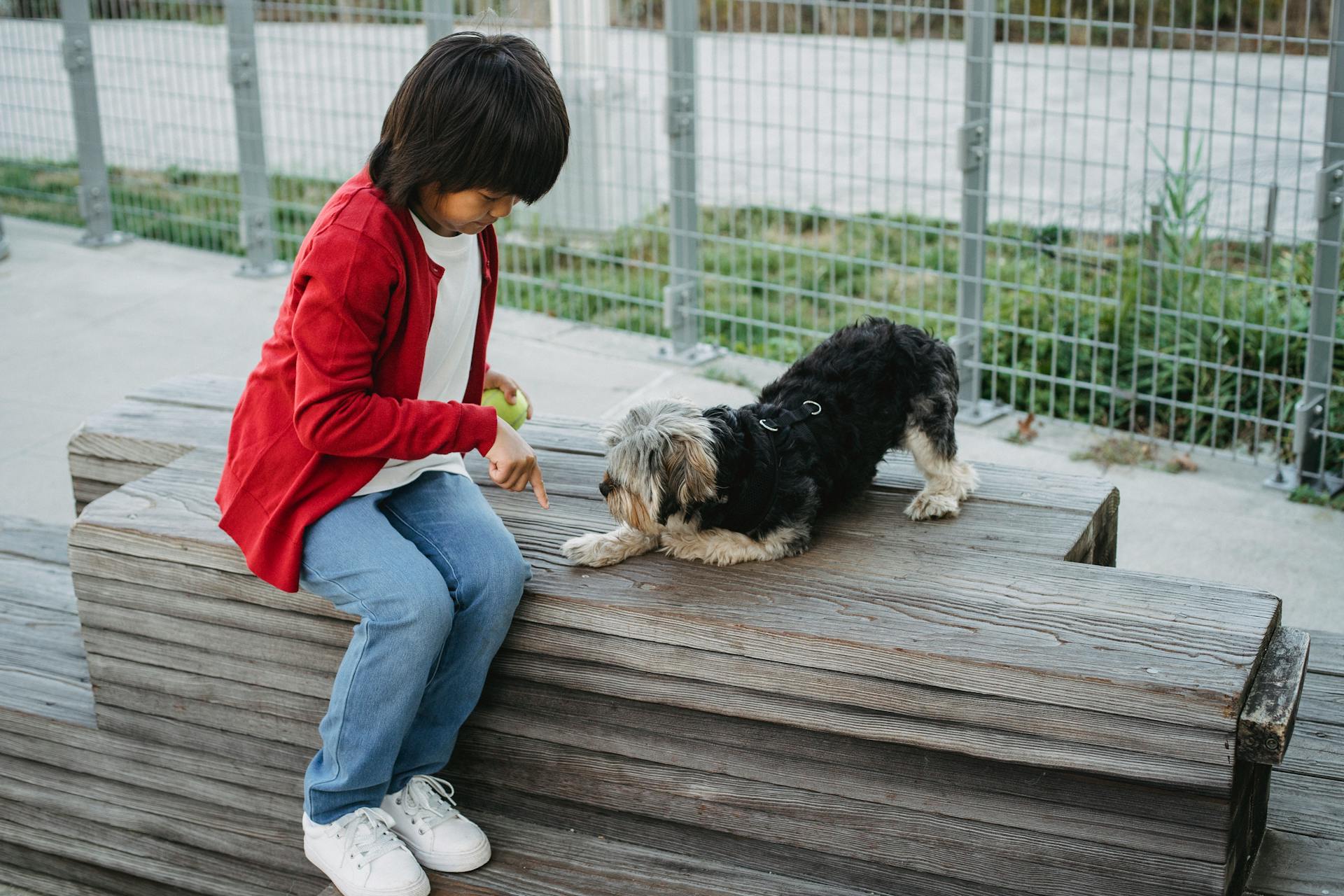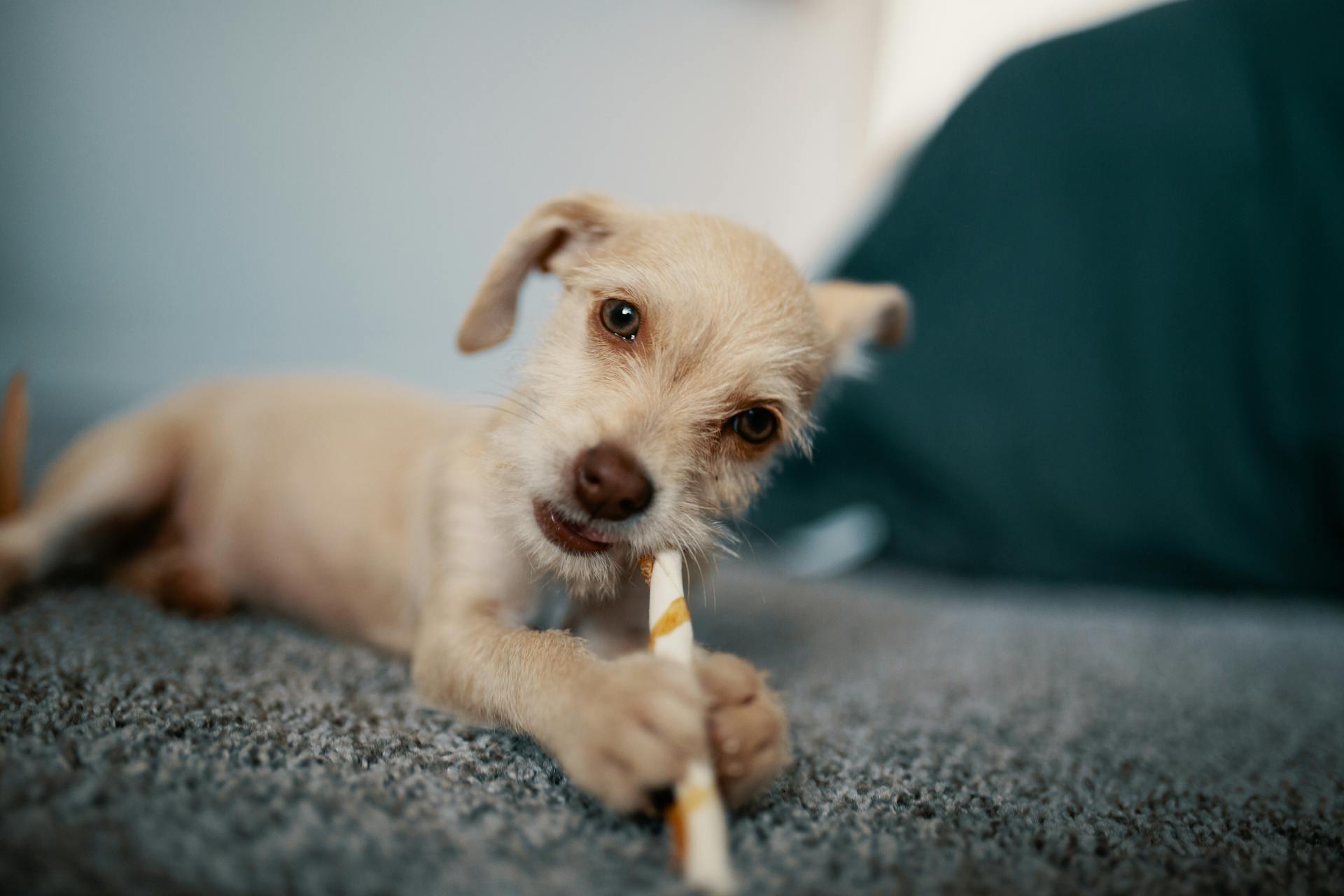
Bell potty training for puppies is a game-changer. It's a method that allows your puppy to communicate their needs to you, making it easier to establish a consistent potty routine.
The key to successful bell potty training is to start with a bell that's easy for your puppy to ring, such as a small bell attached to a door.
See what others are reading: Dog Training Bell
Potty Training Basics
Potty training is a crucial part of raising a well-behaved puppy.
For nighttime potty breaks, plan for one to two breaks for very young puppies or those still new to the home. This can be done by setting an alarm for the first week to ensure consistency.
These breaks should be low-energy and short, just enough time for the puppy to go potty and then back into the crate to fall asleep again. As they settle into a nighttime routine, you can start to extend the amount of time between breaks.
Puppies under four months old may not be able to make it through an entire night without needing a bathroom break, but every puppy is unique, and some may hit this milestone sooner than others.
Consistency is key when using potty bells or buzzers. If you've been rewarding their outdoor house training, they'll learn to associate ringing the bell with going outside.
Training Techniques
You can train your puppy to use potty bells or buzzers by introducing them to the bells first, allowing them to inspect and explore, and then associating the bells with going outside. This can be done by placing the bells near the door and ringing them each time you take your puppy out.
Some puppies can learn to ring the bell quickly, usually within a couple of days, by accidentally bumping into the bells while trying to get treats. Rewarding them heavily for this behavior helps them understand that the bells are for going outside.
To avoid doing the work for your puppy, don't lift their paw for them to hit the bells or touch the bells to their nose. Instead, encourage them to interact with the bells on their own so they learn that they make the bells ring, which then makes the door open.
Using a buzzer or bell that's easily visible and accessible to your puppy is essential for them to learn how to use it. You can place a sticker on the buzzer to help your puppy see where to push with their nose.
It's essential to be consistent in rewarding your puppy for using the bells correctly and to remove them once your puppy is reliably house trained. Some puppies may take advantage of the bells and ring them every time they want to go outside, but with patience and consistency, they can learn to use them responsibly.
By teaching your puppy to use potty bells or buzzers, you can help them communicate their needs more effectively and make the house training process easier for both of you.
Common Issues
Puppies need almost constant supervision during house training, so it's crucial to watch for signs they need to go to the bathroom.
Some common issues that may arise during bell potty training include puppies not learning to associate the bell with needing to go outside, or not being consistent with ringing the bell when they need to go.
Puppies may get distracted or bored with the training process, leading to accidents inside.
If you notice your puppy is suddenly stopping an activity, pacing back and forth, or excessively sniffing, it may be a sign they need to go to the bathroom.
Other signs of needing to go include searching out a more hidden area, whining, sniffing or licking their groin or rear-end area, jumping or pawing at the door, or trying to get your attention with barking or pawing at you.
Here are some common signs your puppy may need to go to the bathroom:
- Suddenly stopping an activity, such as chewing or playing
- Pacing back and forth or in circles
- Excessive sniffing
- Searching out a more hidden area, such as a far corner, behind the sofa, or going into a different room
- Whining
- Sniffing or licking their groin or rear-end area
- Jumping or pawing at the door
- Trying to get your attention with barking or pawing at you
Knowing When to Adjust
If your puppy has been accident-free for a week, you can stretch the timer by half an hour. For example, if you had been taking your puppy out every 60 minutes, now you can take them out every 90 minutes.
Puppies under four months old typically can't make it through an entire night without needing a bathroom break, but every puppy is unique and may hit this milestone sooner or later.
If you have more than two accidents in a week, go back to the previous step where you were successful for an additional week. This will help prevent frustration and ensure your puppy learns to hold it in consistently.
You can stretch the time between potty trips by gradually increasing it, but be patient and remember that "holding it" isn't a skill that comes pre-installed in most mammals.
Accidents and Setbacks
It's normal for regression in potty training as your puppy grows, especially if their routine or environment changes. Don't get discouraged if your puppy has a potty accident inside.
It takes time for your puppy's body to mature enough to hold it throughout the day and night, and consistency in their house training routine to help them learn where they are supposed to go.
Every time you take the puppy inside after an unsuccessful potty trip, the likelihood that his bladder and bowels are full increases with every minute, making accidents more likely.
The first two to three days of this new routine are by far the hardest, but it gets better rapidly after the first couple of days.
Regression in Training
Regression in training is a common occurrence, especially as your puppy grows. It's not abnormal for regression to happen.
Changes in routine or environment can trigger regression, so be prepared to adjust your approach accordingly. Go back a few steps in your puppy's training to get back on track.
Consistency is key in house training, and it takes time for your puppy's body to mature enough to hold it throughout the day and night. You'll need to be patient and consistent in their routine.
A rewards-based training approach can be incredibly helpful in overcoming setbacks. A positive trainer can make a huge difference in your puppy's progress.
A different take: Dog House Training Regression
What to Do in an Accident
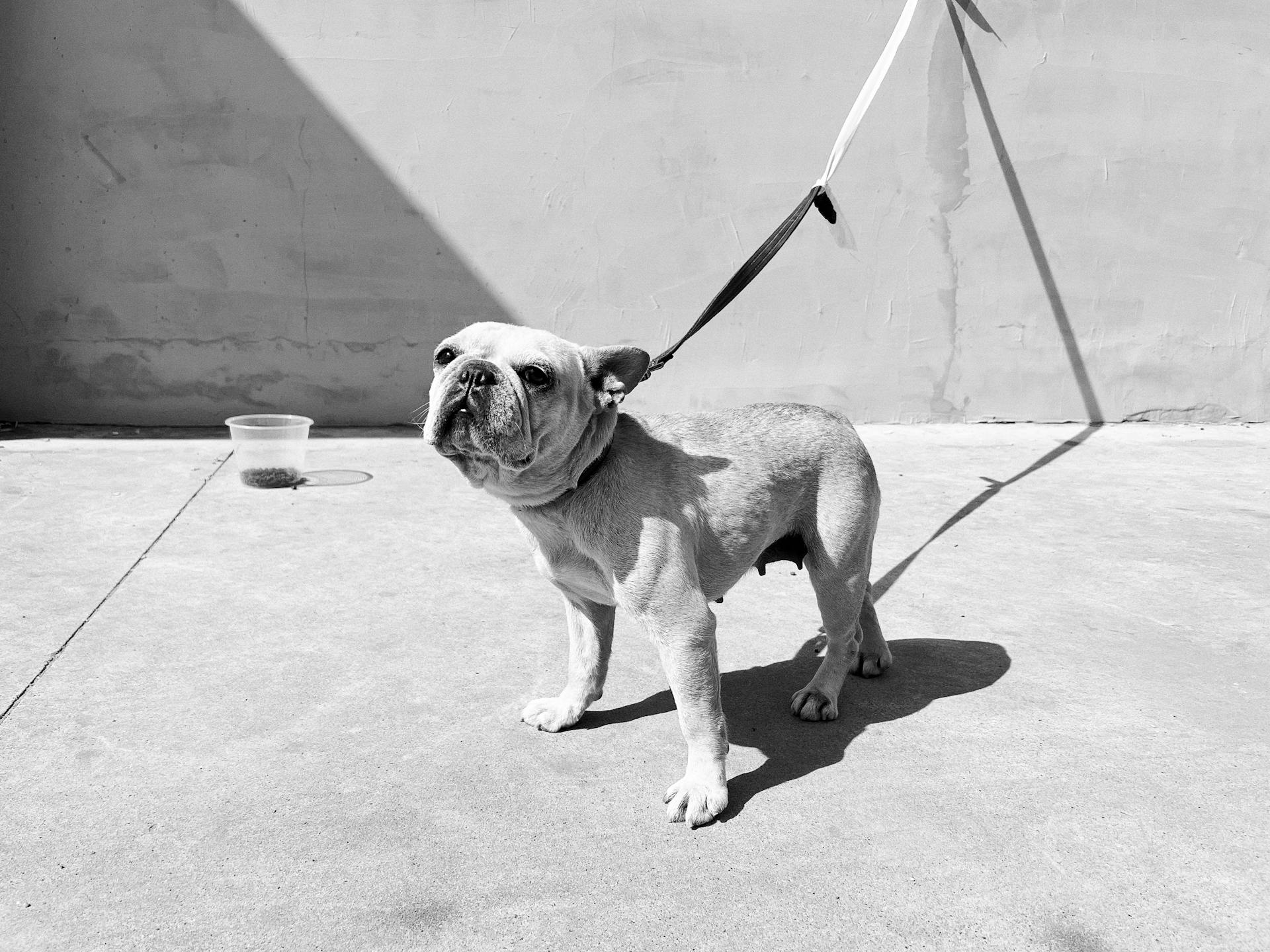
Accidents can happen even with the best training. If you catch your puppy in the act of making a mess, stay calm and act quickly.
Don't do the work for your puppy - instead, encourage them to interact with the bells on their own so they learn that they make the bells ring, which then makes the door open.
If your puppy has learned to ring the bell to get outside, but isn't going potty right away, it's best to bring them back inside right away. This will help prevent them from taking advantage of the bell and abusing their skills.
Some puppies love playing with the bells themselves, which can be a problem if they chew on them or ingest the bells. Be sure to supervise your puppy closely to prevent any accidents.
If you're using a buzzer, make sure the button is easily visible for your puppy to see and then target. You can even use a sticker to help them locate the button, like the blue felt sticker that worked for Finnegan.
How Long Do I Have to Continue?
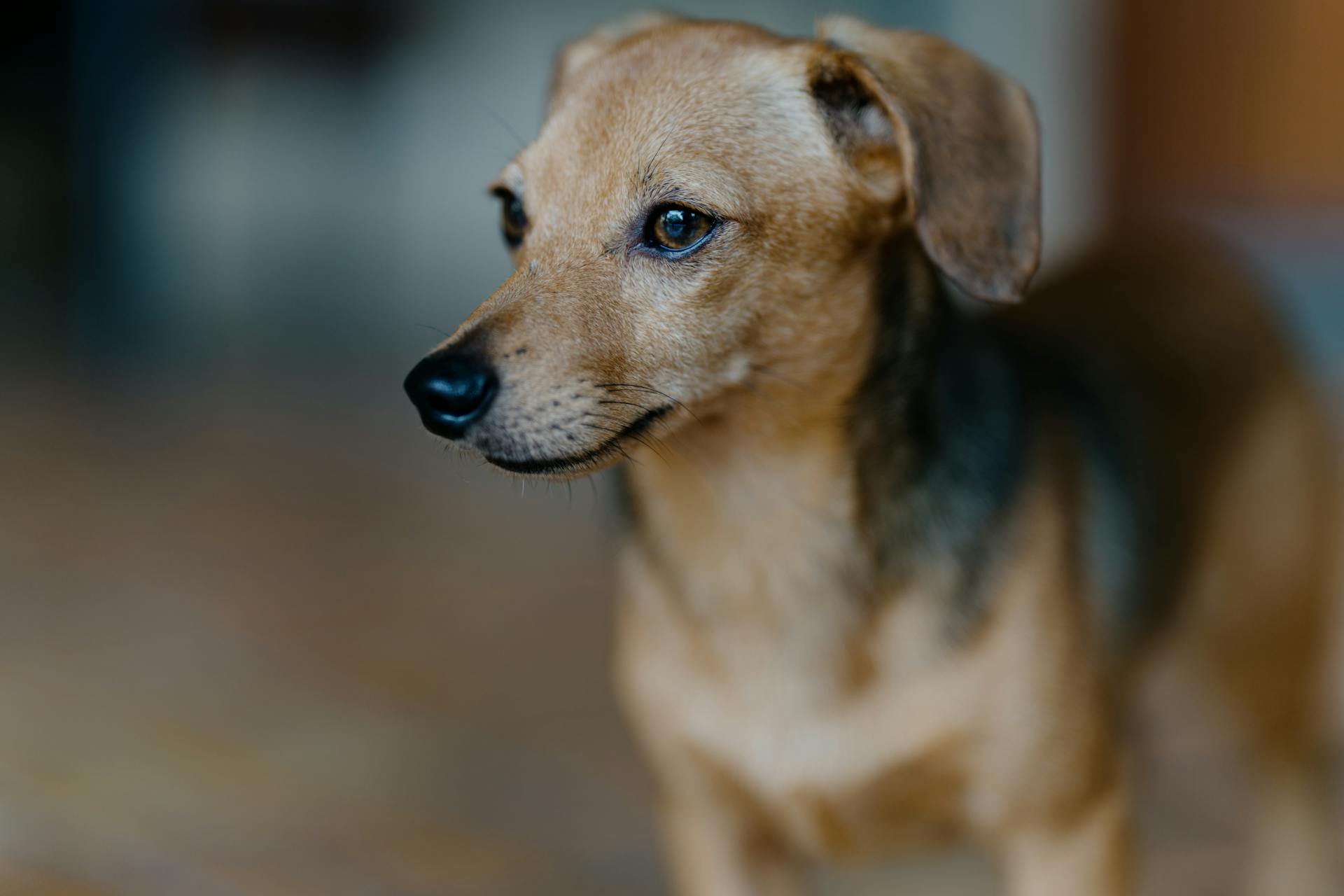
The first two to three days of potty training can be the hardest. Your puppy doesn't know what you want yet, and your whole life has become an endless cycle of letting the dog in and letting the dog out.
It's normal for puppies to regress in potty training as they grow, especially if their routine or environment changes.
The likelihood of your puppy having an accident increases with every minute after an unsuccessful potty trip.
It takes time for your puppy's body to mature enough to hold it throughout the day and night, and consistency in their house training routine to help them learn where they are supposed to go.
Consistency in your puppy's routine and patience during the process will pay off big time in the long run.
You can expect puppies under four months old to need nighttime potty breaks, but every puppy is unique and may hit milestones sooner or later than others.
The first week with your puppy is a good time to set an alarm for nighttime bathroom breaks to avoid waiting for whining or barking.
Every minute counts after an unsuccessful potty trip, so it's essential to get your puppy back to the door quickly to prevent accidents.
Reasons and Considerations
Some dogs struggle to take the initiative to let you know when they need to go, which can make potty training a challenge.
Potty bells give them a systematic way to ask, allowing you to teach your puppy that the bells control the door, and the puppy controls the bells.
A potty bell is an effective tool for dogs that teach themselves to sit at the door, scratch the door, whine or bark to signal they need to go.
Curious to learn more? Check out: Prairie Dogs
Relationship Building
Building a strong relationship with your dog is key to a happy and harmonious household. Most dogs catch onto ringing a bell or pushing a button to get access to going outside very quickly.
This shared language can decrease frustration in the home, making it a win-win for both you and your furry friend. Having a clear way for your dog to communicate their needs can also increase your bond with them.
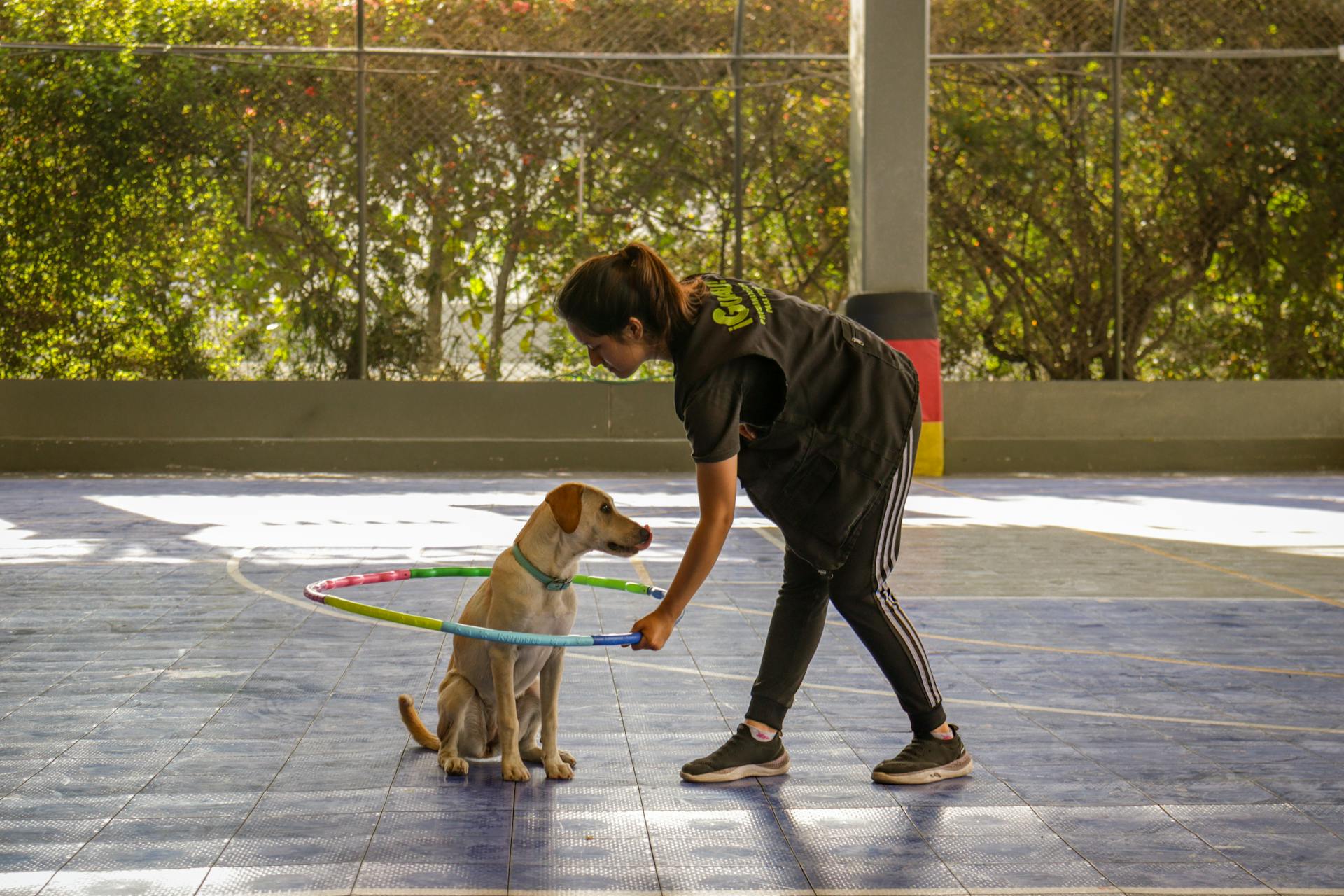
If you have other people living in your home, a bell system can help them understand your dog's needs, especially if they're not attuned to their natural signals. This can reduce misunderstandings and make life easier for everyone.
A bell system can also be a lifesaver when you have a pet sitter staying at your home. It allows your dog to communicate their core needs to the sitter, making the transition smoother and less stressful for both of them.
For your interest: At Home Dog Training Program
Reasons to Use a
Using a potty bell can be a game-changer for some dogs, allowing them to actively signal their owners that they need to potty.
Some dogs teach themselves to sit at the door, scratch the door, whine, or bark to indicate they need to go outside.
Others struggle to take the initiative to let their owners know when they need to use the bathroom.
Potty bells give dogs a systematic way to ask for help, making it easier for owners to respond to their needs.
We can teach our puppies that the bells control the door, and the puppy controls the bells, creating a simple and effective system.
Discover more: Puppy Mills Dogs
Frequently Asked Questions
What is the fastest way to potty train a puppy?
To potty train a puppy quickly, take them outside frequently (at least every 2 hours) and immediately after meals, playtime, and naps, to a designated spot where you can reward them for eliminating. Consistency and positive reinforcement are key to a successful potty training process.
How long does it take to bell train a puppy?
Training a puppy to use a potty bell typically takes just two weeks, even for inexperienced dog owners. With consistent practice, your puppy can learn to ring the bell to signal when they need to go outside.
How to potty train a puppy to go to the door?
To potty train a puppy to go to the door, teach them to ring a bell with a command word, then open the door and take them outside. With repetition, they'll learn to associate the bell with going out.
Sources
- https://www.akc.org/expert-advice/training/potty-training-your-puppy-timeline-and-tips/
- https://www.preventivevet.com/dogs/how-to-potty-train-a-puppy
- https://joleyaire.com/blog/potty-training
- https://www.levelupdogtraining.com/puppy-training-2/puppy-potty-training-planner/
- https://www.akc.org/expert-advice/training/teach-dog-ring-bell-go-outside/
Featured Images: pexels.com
